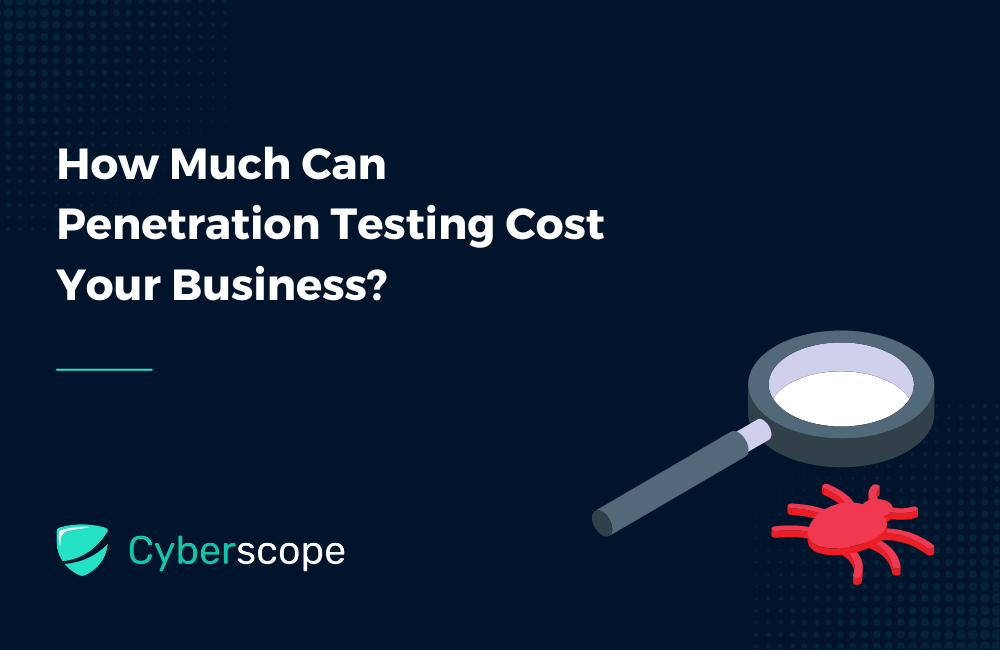.jpg%3Falt%3Dmedia&w=640&q=75)

How Much Can Penetration Testing Cost Your Business?

Introduction
In the rapidly evolving landscape of cyber security, organizations face constant threats from malicious actors seeking to exploit vulnerabilities in their digital infrastructure. One crucial tool in the arsenal of cybersecurity measures is penetration testing, also known as pen testing. This simulated cyber attack on a computer system, network, or application is designed to identify weaknesses and potential entry points that could be exploited by hackers.
In this comprehensive guide, we will explore what penetration testing is, its value to businesses, the associated costs, the stages involved, and the consequences of choosing not to undergo such testing. Additionally, we will discuss how to choose the right penetration testing provider, focusing on the notable capabilities of Cyberscope, a leading cybersecurity company with a strong presence in the blockchain and cryptocurrency space.

What is Penetration Testing?
Penetration testing, also known as pen testing, is like a simulated cyber attack on a computer system, network, or application to identify vulnerabilities. It helps assess the security strength and discover potential weaknesses that malicious hackers could exploit. Penetration testers use various tools and techniques to mimic real-world threats, providing insights for improving the overall security posture. So basically penetration testing allows you to gauge what your infrastructure application or network is like it can allow you to find security holes, plug them, and ensure that your company and its clientele are secure.
This proactive approach not only helps in identifying vulnerabilities but also plays a crucial role in preventing potential cyber threats. By engaging in simulated cyber attacks, organizations gain a deep understanding of their security landscape, allowing them to fortify defenses and protect sensitive information. The insights obtained from penetration testing enable businesses to stay one step ahead of malicious actors, fostering a resilient cybersecurity posture.
Why Conduct Penetration Testing?
Penetration testing is crucial for organizations for several reasons. It helps identify vulnerabilities in systems, networks, or applications, allowing proactive risk mitigation and prevention of potential cyber threats. Compliance with industry standards and regulations is facilitated through regular testing. Additionally, penetration testing enhances incident response readiness, builds trust with stakeholders, prioritizes remediation efforts, and promotes security awareness among employees. The process contributes to reputation protection, and continuous improvement in cybersecurity, and informs strategic decision-making for technology investments and risk management. Overall, penetration testing ensures a proactive and strategic approach to cybersecurity, safeguarding organizations against evolving cyber threats.

What Is The Value Of Penetration Testing In Business?
Penetration testing offers several benefits:
- Enhanced Incident Response: Penetration testing helps organizations refine their incident response plans by providing insights into how well security teams can detect and respond to simulated cyber attacks. This proactive approach prepares businesses for real-world incidents.
- Third-Party Assurance: For businesses in partnerships or collaborations, penetration testing can serve as evidence of a strong security posture. This can be crucial in building trust with partners, clients, and stakeholders, showcasing a commitment to protecting shared information.
- Prioritization of Remediation Efforts: Through the identification of vulnerabilities, penetration testing enables organizations to prioritize and address the most critical security issues first. This targeted approach ensures efficient use of resources to enhance overall cybersecurity.
- Security Training and Awareness: Penetration testing often reveals human-centric vulnerabilities, such as employees falling for phishing attacks. This insight prompts organizations to invest in security awareness training, educating staff on potential threats and how to avoid them.
- Avoidance of Reputation Damage: Detecting and fixing vulnerabilities before they are exploited by malicious actors helps prevent data breaches and other security incidents that could damage an organization's reputation. Maintaining a positive public image is crucial for customer trust and business success.
- Comprehensive Risk Management: By regularly conducting penetration tests, organizations can establish a continuous risk management process. This involves identifying, assessing, and mitigating risks in an ongoing cycle, and adapting to the evolving threat landscape.
- Competitive Advantage: Demonstrating a commitment to cybersecurity through penetration testing can give businesses a competitive edge. Clients, partners, and investors are likely to choose organizations that prioritize security, especially in industries like cryptocurrency and blockchain.
- Legal and Regulatory Compliance: Penetration testing assists in meeting legal and regulatory requirements for data protection and cybersecurity. Compliance with standards such as GDPR, HIPAA, or industry-specific regulations is crucial for avoiding legal consequences.
- Demonstrable ROI: While penetration testing involves an upfront cost, the long-term return on investment is evident in the potential savings from avoiding data breaches, downtime, and the associated costs of remediation.
- Strategic Decision-Making: Insights gained from penetration testing can inform strategic decisions related to technology investments, cybersecurity policies, and future risk management strategies, aligning security efforts with overall business goals.

How Much Does Penetration Testing Cost?
The cost of penetration testing is influenced by various factors, with the scope, complexity, and size of the systems under examination being primary considerations. Organizations can expect a diverse range of prices, typically spanning from a few thousand to tens of thousands of dollars. The variation in costs reflects the different levels of scrutiny and depth of testing required to thoroughly assess the security posture of the targeted infrastructure.
To obtain a more precise estimation tailored to your organization's unique circumstances, it is advisable to engage directly with a cybersecurity service provider, such as Cyberscope. Contacting experts in the field allows for a detailed discussion of your specific needs and requirements. During this consultation, factors like the intricacy of your systems, the extent of the testing required, and the particularities of your organizational infrastructure can be thoroughly examined. Cyberscope and similar providers possess the expertise to offer a customized quote that aligns with the nuances of your digital environment, ensuring that the penetration testing process is comprehensive and effective.
The 5 Stages of Penetration Testing
The penetration testing process typically involves the following five stages:
- Planning: Define the scope, objectives, and goals of the penetration test. Identify the systems and networks to be tested, and establish rules of engagement. This stage includes obtaining necessary permissions and approvals.
- Reconnaissance: Gather information about the target systems, networks, and applications. This involves passive reconnaissance, where publicly available information is collected, and active reconnaissance, where more direct probing may occur.
- Scanning: Conduct a vulnerability assessment to identify potential entry points and vulnerabilities in the target environment. This stage involves using tools to scan for open ports, services, and known vulnerabilities.
- Gaining Access: Attempt to exploit identified vulnerabilities to gain access to systems or sensitive information. This phase simulates the actions of a real-world attacker and may involve the use of ethical hacking techniques.
- Analysis and Reporting: Evaluate the results of the penetration test, documenting the findings, potential risks, and recommended remediation measures. The final report provides actionable insights for improving the overall security posture.
These stages ensure a systematic and thorough approach to identifying and addressing security vulnerabilities in an organization's systems and networks.

Consequences of Not Undergoing Penetration Testing
If you choose not to undergo penetration testing, your organization may face several risks and potential consequences:
- Unidentified Vulnerabilities: Without testing, undiscovered vulnerabilities in your systems, networks, or applications may remain unknown. This leaves your organization exposed to potential exploitation by malicious actors.
- Security Incidents: Lack of proactive testing increases the likelihood of security incidents, such as data breaches, unauthorized access, or disruptions to your services. This can lead to financial losses, damage to reputation, and legal consequences.
- Regulatory Non-Compliance: Many industries and regulatory bodies require regular security assessments, including penetration testing, to comply with standards and regulations. Failure to meet these requirements could result in legal penalties and fines.
- Poor Incident Response: Without understanding how well your organization can detect and respond to security incidents, you may have a less effective incident response plan. This can lead to prolonged downtime and increased damage in the event of a real cyber attack.
- Lack of Stakeholder Trust: Third parties, such as clients, partners, and stakeholders, may question the security of your systems if you don't demonstrate a commitment to regular penetration testing. This can erode trust and impact business relationships.
- Missed Remediation Opportunities: Without identifying vulnerabilities, you may miss opportunities to prioritize and address critical security issues. This targeted approach is crucial for efficiently strengthening your overall cybersecurity defenses.
- Limited Security Awareness: Without the insights gained from penetration testing, employees may lack awareness of potential security threats and best practices. This can result in a higher likelihood of falling victim to social engineering attacks or other human-centric vulnerabilities.
- Reputation Damage: Failing to address security vulnerabilities leaves your organization susceptible to data breaches, which can harm your reputation. Maintaining a positive public image is essential for customer trust and overall business success. No Continuous Improvement: Regular penetration testing establishes a cycle of continuous improvement in cybersecurity. Without this process, your organization may struggle to adapt to evolving threats and implement necessary improvements over time.
- Missed Strategic Insights: Insights gained from penetration testing inform strategic decision-making, helping align security efforts with overall business goals. Without this information, your organization may make less informed decisions regarding technology investments and risk management.
In summary, foregoing penetration testing exposes your organization to potential vulnerabilities, security incidents, regulatory non-compliance, and risks to reputation and trust. Regular testing is a proactive measure to identify and address these issues, ensuring a more secure and resilient cybersecurity posture.

Choosing the Right Penetration Testing Provider
In selecting a penetration testing provider, Cyberscope emerges as a distinguished choice due to its extensive expertise and notable presence in the cybersecurity space, particularly in blockchain and cryptocurrency. Renowned for its industry-specific knowledge, Cyberscope aligns its services with regulatory requirements and offers a tailored approach to testing methodologies, ensuring a comprehensive assessment of systems, networks, and applications. The company emphasizes clear and transparent communication, delivering reports with actionable insights. Cyberscope's commitment extends beyond testing, providing post-assessment support, and engaging in ongoing discussions to address evolving security needs. While considering cost, Cyberscope's reputation for quality services positions it as a trusted partner, combining technical proficiency with a dedication to client satisfaction.
Conclusion
In conclusion, penetration testing is a critical component of a robust cybersecurity strategy, offering businesses invaluable insights into their digital defenses. Organizations can proactively identify and address vulnerabilities by simulating real-world cyberattacks, ultimately strengthening their overall security posture. Moreover, it aids in comprehensive risk management, providing a continuous cycle of identifying, assessing, and mitigating risks in response to the evolving threat landscape.
Choosing not to undergo penetration testing exposes businesses to a myriad of risks, including unidentified vulnerabilities, security incidents, regulatory non-compliance, and damage to stakeholder trust. Embracing penetration testing ensures organizations stay secure, stay confident, and are well-prepared to navigate the complexities of the modern digital landscape.
Recent Posts
.jpg%3Falt%3Dmedia&w=640&q=75)


What is a Fallback Attack in Smart Contracts?
6 months ago
